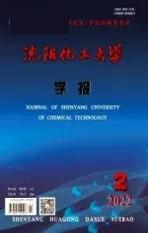Reuse of Waste Glass via an Economic Treatment Process
2013-10-30SIVAKUMARWANGLiZHOUYun
SIVAKUMAR M, WANG Li, ZHOU Yun
(1.Sustainable Earth Research Centre,Faculty of Engineering,University of Wollongong,NSW 2522,Australia;2.College of Environmental& Safety Engineering,Shenyang University of Chemical Technology,Shenyang 110142,China;3.College of Resources&Environmental Engineering,Wuhan University of Science&Technology,Wuhan 430081,China)
In waste glass recycle,the comminution process is required to crush and give the perfect size without over crushing.Due to relatively fragile nature of the waste glass and the undesirability of fines,a relative high throughout and low price process and equipment is needed in their treatment,but the crushing process mostly from mineral crushing although some process is available in the web[1].A few models are used to predict the size distribution in the crushing process except the coal crushing process.Waste glass is a potential solid waste and currently disposed in landfills at high cost in Wollongong,Australia[2].Before the adequacy and sustainability of waste glass management systems,based largely on sanitary landfills and cullet reused for containers,was severely questioned by market,economy and land space.Recent trends in waste management and increased community awareness of environmental issues and landfill site scarcity,have led to formulate waste minimisation and recycling policies and strategies in Australia[3].The Commonwealth Environment Protection Agency in consultation with the Australian and New Zealand Environmental and Conservation Council(ANZECC)released a National Waste Minimisation Strategy[4]in June 1992.The national strategy set the target of a 50%(60%in NSW)reduction of waste going to landfills in 2000.Resource recovery was a principal component of this strategy through recycling,reuse and composting[5].
The sources of waste glass include waste glass produced in industrial,trade,agriculture and domestic sources.Waste glass is recycled primarily for cullet in glass manufacturing for new glass beverage containers.Successful recycling needs to be commercially driven and its viability depends on the availability of suitable markets for the products which are made,however demand for recovered waste glass is slowing in our region.The environmental value as well as the economic value must be taken into account in assessing suitable markets[6-7].Markets of recycled glass can be expected to recognize their expended responsibility for the products they sell.The waste glass has also been tried to recycle in construction materials,tiling,aggregate,replacement for sand as a water filler medium and so on.In the research the waste glass collected and not recycled from kerbside collections was concerned,including broken bottles,broken window glassand broken windscreen glass.It was thought as the aggregates,which are basic applications to substitute natural aggregate materials from an engineering perspective will depend on the relative performance of the final waste glass products versus the original natural products and the economics process chosen.This paper aims to find a predicted model and its safety assessment method for a sound,beneficial,environmental and engineering solutions for the waste glass aggregate disposal.More specifically the research work has been done for waste glass aggregate.Rational approaches are discussed to gain a better understanding for the treatment[8-10].
1 Sources of Experimental Waste Glass
Waste glass samples are taken according to the Australian standard methods for sampling and testing aggregates[11](1141.3.1 sampling aggregates).The waste glass samples were collected from Kiama.Waste glass had separated by hand by colors.Two sources of waste glass were used before separation and after separated were selected for this experiment.The source of raw waste glass collected was shown as the table 1.

Table 1 Source of waste glass
2 Methods of Experiment
According to the relative Australian Standard 1141 and 4454 for sampling and testing[11-12],the materials and equipment were selected because there is no applicable waste glass aggregate standard at present.The main materials and equipment are shown as table 2.The research procedure is shown as following:figure 1.
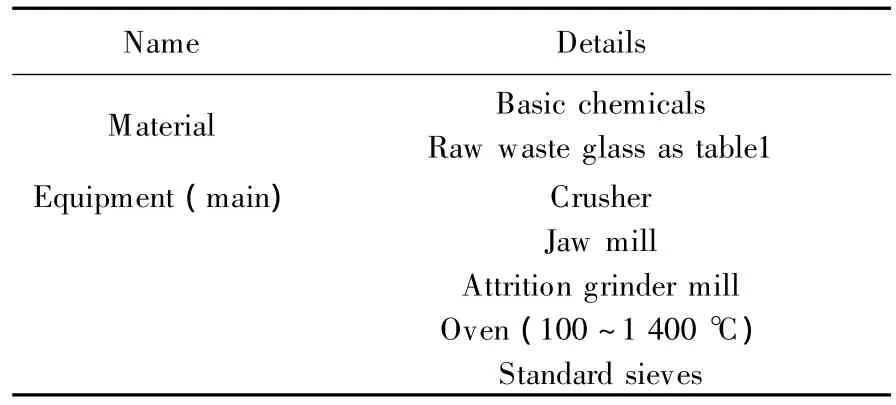
Table 2 Materials&equipment(main)
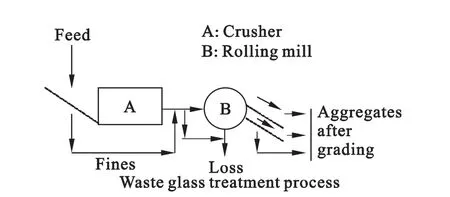
Fig.1 Waste glass treatment processes for the aggregate
To decide whether waste glass is judged fit for garden use,analysis & diagnosis of products have been performed using the Australian Standards.These parameters are particle size distribution,porosity,bulk density,durability and pollutants in waste glass and etc[13].As new alternative uses for recycled glass are developed,there is a need for a parallel development of specifications and tests to define the application for use of particular supplies of glass in specific applications.
3 Results and Discussion
3.1 Treatment Process of Waste Glass Aggregate
After a world-wide literature review conducted using the online resources available at the University of Wollongong and City Council libraries[14],it was identified that possible reuse methods of waste glass which are relevant to the local community,including the advantages and potential disadvantages.Identifying the characteristics of the raw glass waste and processing them suitably in batches involved the testing of appropriate properties which were studied as a main application as potting mix sand replacement.Systematic laboratory tests were conducted which determined the environmental and engineering properties of the processed product based on Australian and New Zealand Standards.
Treatment processes was chosen when the characterisation study of the raw waste glass was completed.It was then treated by many methods.A hammer mill crusher with attached sieve and drum mill were be used as the main equipment to break down the glass to the required size and shape[1].If necessary,other material processing equipment such as the ball mill crushers were tried.figure 2 shows the economic process of waste glass aggregate as the engineering application.
There is a two step process to treat the waste glass to change it into the safety aggregate.The first step is the waste glass is crushed for particles as per the discussion before,and the second step is the process for rounding the aggregate so that the waste glass particles can be made into safely waste glass aggregate for reuse.By research the rolling mill was selected as the treatment for this process.The whole of process shows in the figure 1.
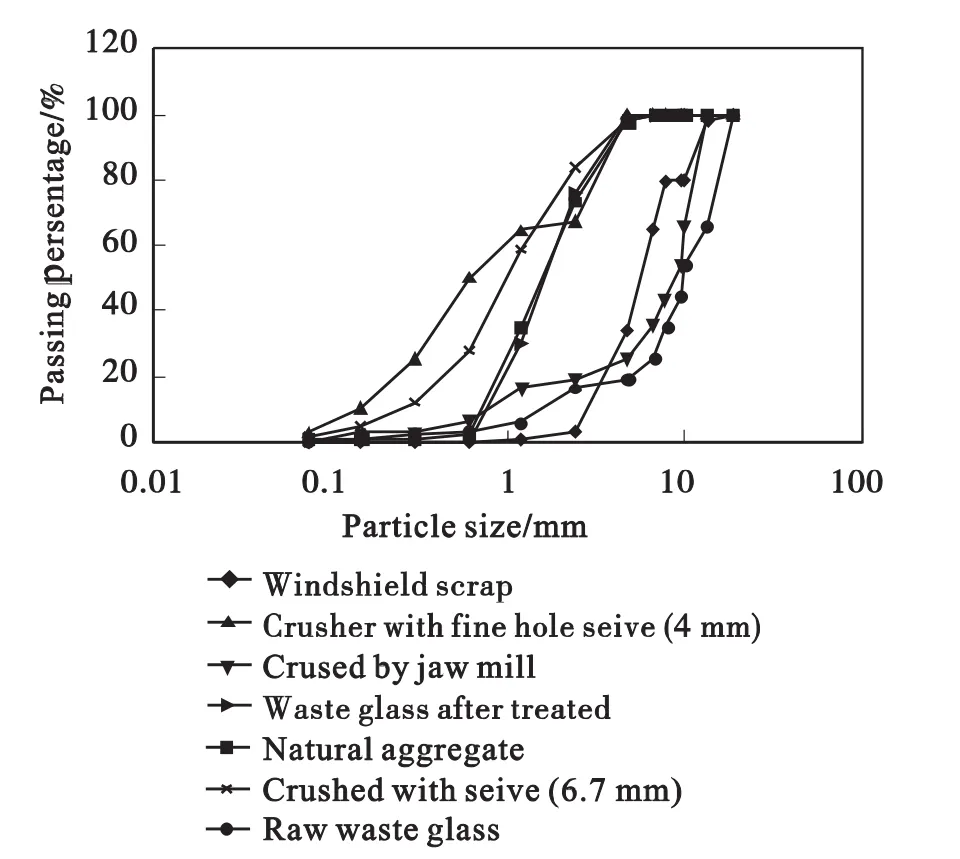
Fig.2 Particle size distributions of waste glasses
Figure 1 is the process for rounded the aggregate.The mass balance for this process is given as below.

From equation(1)the following can be derived,

In which P is the product,F is the feed,L is the loss,t is the time,k is the constant and a is the conversion rate.
According to this process,the process function from equation(2)is:

Equation 1 represents a crushing process and equation 2 is an autogenously abrasion process.The loss rate and time will affect this process,in which the second step is the control step as determined by research for the time taken,so the process efficiency will be improved when the control step’s problem is solved.Equations 3 and 4 simply describe the crushing process and rounding process.Efficiency can be improved depending on amount of P1,a2and time taken in the process.When force is used efficiently the processing time is saved.
As waste glass easily broken if it is subjected to an impaction force or a swift,violent blow,a slow continuous force is used for making waste glass rounded aggregate.From careful observation there are two general phenomena in the behaviour of making waste glass rounded aggregate.Waste glass aggregates flow and they are continuously pressured for a long enough time,they show the severe permanent deformation needed for rounded aggregate in the autogenous(rolling)mill.When the rolling mill’s velocity is increased,the speed of impact of the force is greater.For the fragile nature of waste glass an optimal range has been selected for waste glass reused as rounded aggregate because of the ultimate strength or stress needed.From this concept the critical point of stress has been derived for the waste glass[15].
The critical point of breaking stress in kg/cm2=4 600/log10(t/6) (time in ms) (5)
This can be interpreted in its extreme form as stating that an infinite time the breaking stress is zero,however if the time is less than 6 ms(milliseconds),no force is great enough to break waste glass.
3.2 Prediction of Waste Glass Aggregate Production
To predict the production of waste glass aggregate it is needed to differentiate and analyze how the waste glass aggregates are produced and which parameters are important in the treatment process.The waste glass aggregate has two important properties,which are the appropriate size,and safe property or non-sharpness.From figure 2 it is known that the two procedures are included for treating waste glass aggregate.Ideally waste glass aggregate would be produced when waste glass was comminuted and made safe by the autogenous mill,and then the process would cease as soon as it reached the size desired.For setting up the model,this treatment process is separated to two stages,which they are a crushing stage and a rounding stage as described above.The behavior of each size grade and the comminuting action should be considered and for simplifying,the assumption made is that the waste glass aggregate size distribution is determined by sieve size when the waste glass is crushed and then fed to the rolling mill under a narrow size range and this total load remains constant only provided to the mill.The separation efficiency is independent for the different size ratio of input and output in the process.The assumption is true after observing the evidence.
Let the total load on the mill be F,and P1and P2are separating the waste glass aggregate and the safety waste glass aggregate from the process,and L is loss because of the particle size being smaller than its using size.The mass equations are from above and now a narrow size range of Xiis be considered to comminute into fractions a11,a21,…,ai1and a11,a21,…,ai1so that ai1is the fraction of size range i from the feed range,and then W1will be made up of
P1=x1(a11)+
x2(a21+a22)+
x3(a31+a32+a33)+…+
xi(ai1+ai2+…+aii)
P2=X1(a11)+
X2(a21+a22)+
X3(a31+a32+a33)+…+
Xi(ai1+ai2+… +aii),
In matrix form,
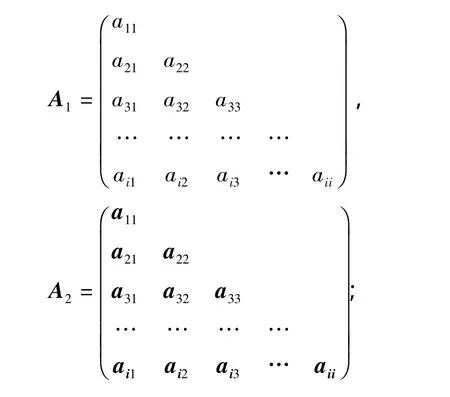

Waste glass aggregates from the different size ranges of x and X are classified and treated according to their size(i)by the separation efficiency α1,α2.The quantities of x and X,which they are stage one and two,in the different size ranges 1,2,3…,and x1,x2,…,xiand X1,X2,X3… are set up from the process as below from the equation(3)and(4).

From equation(6)we can get

and let

The equation can be written in matrix form:

and multiplying through by A to bring all matrices to the same order,


The example is given below,which the columns and rows of the matrix are started from the mean particle size:8 750,7 350,5 450,4 050,2 860,1 770,905,565,400,225,123,and 38 μm in the particle size radio distribution of natural aggregate substituted.F is amount of feed to the system,and assumes the mean size of broken bottle is larger than 4 050 μm,K is a constant when the process is under the stable state for needing the aggregate.P2can be derived by using α1,α2and A2as below.
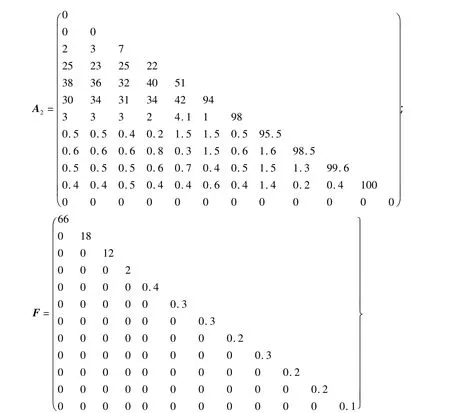
Using MATLAB the waste glass aggregate can be predicted.
3.3 Particle Size Distribution of Natural Fine Gravel or Waste Glass Samples
Particle size distribution of both the natural aggregates and the waste glass aggregates were determined by sieve analysis.Particle shape was also determined for each particle size.The plots include natural aggregate,waste glass with and without treatment,waste glass of windows,before and after processing,and windshield scrap before and after processing.It was found that the raw waste glass and wind shield scrap particle size ranged from 0.1 mm to 20 mm with 50%passing through a sieve of 10 mm and 5.5 mm respectively.The distribution curve of waste glass after the treatment is very similar with the distribution curve of natural aggregate and the particle size distribution is from 0.6 mm to 5.0 mm.
The natural aggregate however is much smaller with 62%passing through 1.18~4.75 mm sieve.Hence processing was essential to reduce the size distribution of the raw waste glass.This shows that the waste glass aggregate can be processed to match natural aggregate or to any other required size distribution.The aggregate size distribution can be adjusted by grade and burden when needed.The other curves show the cullet size distribution and when treated by the crusher,the best selection sieve is used.The best aggregate as the natural aggregate is produced by this method at the maximum rate[16].
3.4 Properties of Waste Glass Aggregate
It is important that properties of waste glass aggregate are known if it is to be used as a potting mix substitute.A waste glass is reused for the garden;pollutants should be measured,in particular,heavy metals in the waste glass.The instrumental method of atomic absorption spectrometry is used to analyze for the metals in waste glass in this experiment.The results show that the concentration of Cu,Pb,Fe,Zn,Mn,Cr,Ba and Cd are much less than the standard in leached and solid samples.The concentration is lower than ppb levels.Otherwise,the density of waste glass aggregate is very similar to natural aggregate from 2 350 to 2 650 kg/m3,and the density is able to assess the transformation and storage volume in engineering uses.The results also show that the bulk density increases to accompany with treatment time,but the porosity decreases in the process.The leached wastewater properties show that this wastewater is not toxic and treated easily in the experiment.
The results show this wastewater has no problems complying with wastewater standards[17]and the heavy metals less concentrated than in the leached water of waste glass aggregate(table 3).The BOD5comes from the food in the containers.

Table 3 Main characteristics of washing wastewater*
3.5 Waste Glass Dust Control in Process
In this investigation the dust is mainly produced from the crushing process and it is found that it can be control if the equipment runs in a sealing well system or uses a bag filter.The samples were analyzed by the microscope depending on the air pollution analysis method,and the result shows that the range of particle size is from 0 to 40 μm.Further,the benefits of understanding dust concerns and taking protective measures can be quantified by the reduced exposure to liability claims.The problem of waste glass dust can be solved as long as the correct methods are used in the recycling process.During system design is the best time to consider integrating dust control into the processing system.There are many dust control systems which can be selected in the future design.
3.6 Removing Label Adhesives and Caps in Waste Glass Container
Removing the adhesive label and caps has been studied in the treatment process[3].By experimentation one of the most effective methods was used for this treatment,which is crushing the waste glass to reduce its size.As labels are very light,it is very easy to remove then by screening separation of the particle density of the glass is heavier than the broken labels.However,the caps are removed separately as waste glass is more fragile and was less extension than the container caps when treated by jaw crusher.
4 Conclusions
As water filler medium or electromagnetized wastewater filler medium in wastewater treatmen waste glass is a potential solid waste and is currently disposed in landfill at high cost.This project has found sound beneficial environmental and engineering solutions for waste glass disposal within the Illawarra area.More specifically they are:
(1)Reviewed literature and identified possible reuse methods of waste glass relevant to the local community.Around the world,waste glass is recycled primarily for cullet in glass manufacturing for new glass beverage containers.However,it is also used extensively for construction materials,in tiles,aggregate,replacement for sand,garden mulch,asphalt base course in pavement construction,cement additive which is material component of cement introduced prior to kiln firing,tiles and synthetic marble etc.Assessing the local conditions the first choice for reuse should be garden mulch for the recycled waste glass because it is easy to manufacture,and then waste glass should be reused as construction materials and asphalt.Further research is needed in this field.Waste glass aggregates from the waste glass are being tested as water and wastewater filter media.
(2)In this paper,the novel,economic and easy operation method was developed,which involved the simple crushing and rounding equipment with sieving in the process.The equipment were selected by reasonable techniques,which were applied to get very good products from the different waste glasses.The product ratio of waste glass aggregate is 62%when waste glass aggregate size range is between 1.18 mm to 4.75 mm.
(3)The physical and physic-chemical characteristics of aggregate have been compared with substitution materials and natural materials for garden applications.The results show that concentration of the heavy metals is lower from the leaching wastewater of the waste glass aggregate.BOD5concentration is about 20~35 mg/L and meets Australian standards.
(4)The safety assessment method has been set up to determine the safe index and have succeeded in assessing the safety.The safe index of waste glass aggregate shows the safety.The results show that the waste glass aggregate is very safe and is strengthen by microscope surveys.
(5)Finding the innovative reuses of recyclable materials in construction and highway pavement and studying to provide valuable insights into the long-term performance and durability and economic issues of materials in the future.
Acknowledgements
The authors wish to acknowledge the support given by Sustainable Earth Research Centre Faculty of Engineering,University of Wollongong and Resources,NSW (IllawarraWasteBoard).Also thanks for help from Mr.I J Laird,Ms.J.George,Mr.N Gal,Mr.D Cook and S Rodd during experiment.Healthy Earth Company and Botanic Garden of Wollongong Council also supplied some equipment and place in this research.The work was also supported by National science&Technology support programs(2012 BACO2B04).
[1] Heng R,Cheng K,Tuppurainen D,et al.Mechanistic Modelling of Mineral Sizers[J].Minerals Engineering,2003,16(9):807-813.
[2] Domenico Tony De.No Waste by 2010:A Waste Management Strategy for Canberra[M].Canberra:Publications and Public Communication for ACT Waste,1999:61-65.
[3] Catherine Carter.Development Control Code for Best Practice Waste Management[M].Canberra:Property Council,1999:148-152.
[4] Environmental Protection Agency.Washington,D.C.Characterization of Municipal Solid Waste in the United States:1992 Update[R].Prairie Village:Franklin Associates,Ltd,1992.
[5] Environmental Protection Agency.Australia State of the Environment 1996[M].Canberra:The State of the Environment Advisory Council,1996:17-20.
[6] Yuan Hongping,Shen Liyin.Trend of the Research on Construction and Demolition Waste Management[J].Waste Management,2011,31(4):670-679.
[7] Disfani M M,Arulrajah A,Bo M W.Environmental Risks of Using Recycled Crushed Glass in Road Applications[J].Journal of Cleaner Production,2012,20(1):170-179.
[8] Zhao Hui,Sun Wei.Study of Properties of Mortar Containing Cathode Ray Tubes(CRT)Glass as Replacement for River Sand Fine Aggregate[J].Construction and Building Materials,2011,25(10):4095-4064.
[9] Lee Gerry,Poon Chi Sun,Wong Yuk Lung,et al.Effects of Recycled Fine Glass Aggregates on the Properties of Dry-mixed concrete blocks[J].Construction and Building Materials,2013,38:638-643.
[10] Standards Australian International Ltd AS.1141.12-1996 Methods for Sampling and Testing of Aggregates Materials Finer than 75 Micrometre in Aggregates(by washing)[S].Canberra:The Standards of Australian International Ltd,1996:8.
[11] Standards Australian International Ltd.AS 4454-2003 Composts Soil Conditioners and Mulches[S].Sydney:Australia Standard,2003:5.
[12] Cosentino P J.Developing Specifications for Waste Glass and Waste-to-energy Bottom Ash as Highway Fill Materials[J].Florida Institute of Technology Journals,1995(2):14-18.
[13] Wollonging City Council.State of the Environmental Report[EB/OL].(2000-12-13)[2001-03-15].http//www.wollongong.nsw.gov.au.2001.
[14] George C L.Crushing and Grinding:The Size Reduction of Solid Materials[M].London:Butter-worths,1974:44-46.
[15] Gillot J E,Wang H.Improved Control of Alkali-silica Reaction by Combined Use of Admixture[J].Coment and Concerete Research,1993,23(4):973-980.
[16] Franklin Assoc.Characterization of Municipal Solid Waste in the United States[M].Newyork:Biblio Gov,1996:189-193.
[17] Fleming William J.Standard Methods for the Examination of Water and Wastewater[M].Washington:American Public Health Association,1998:74-76.
